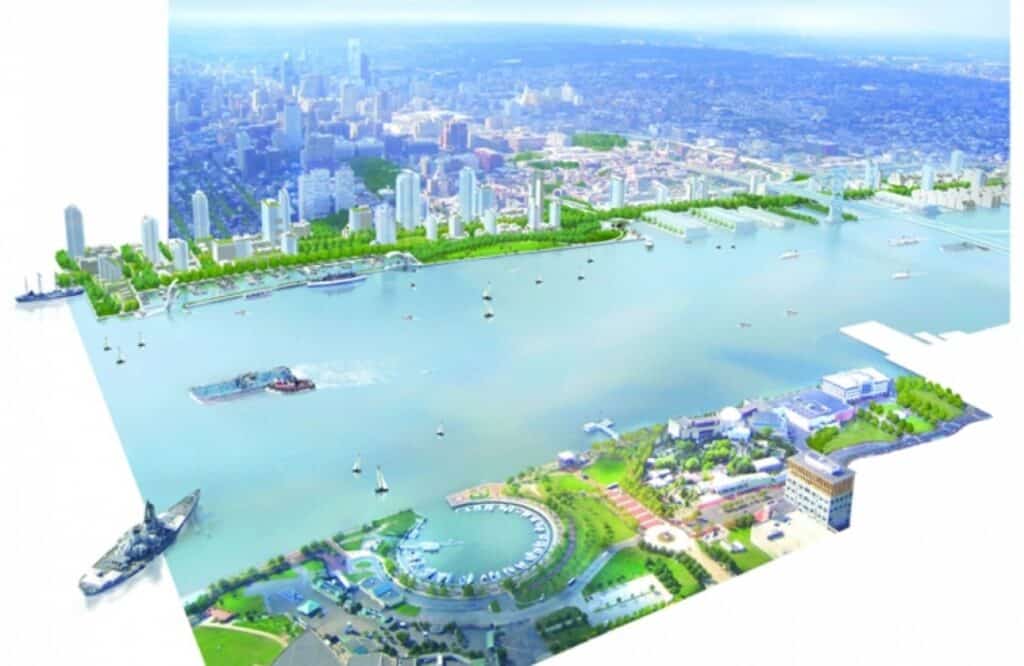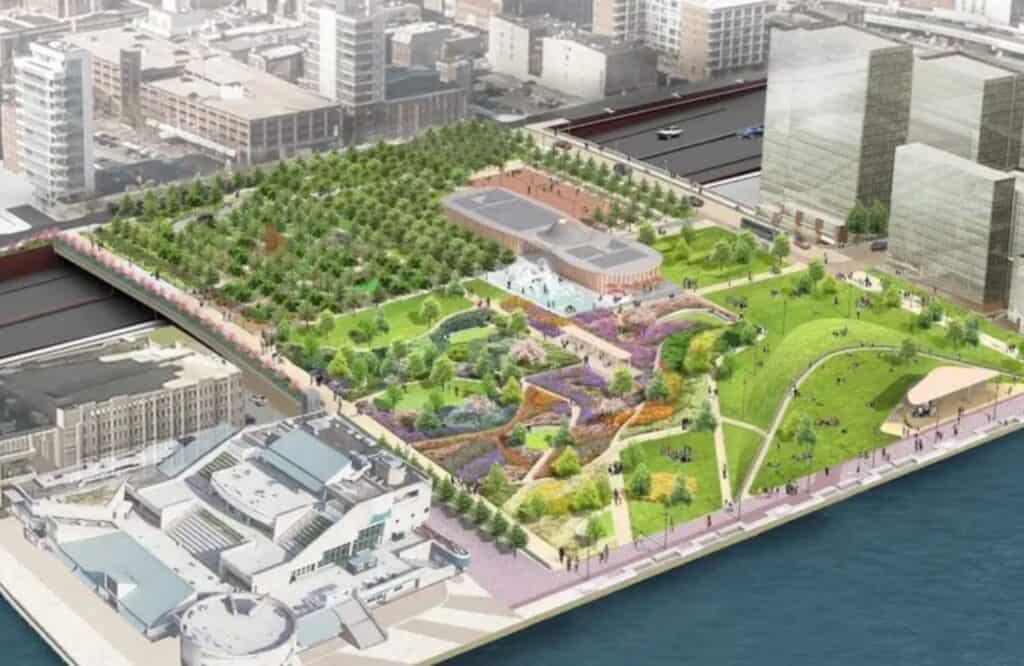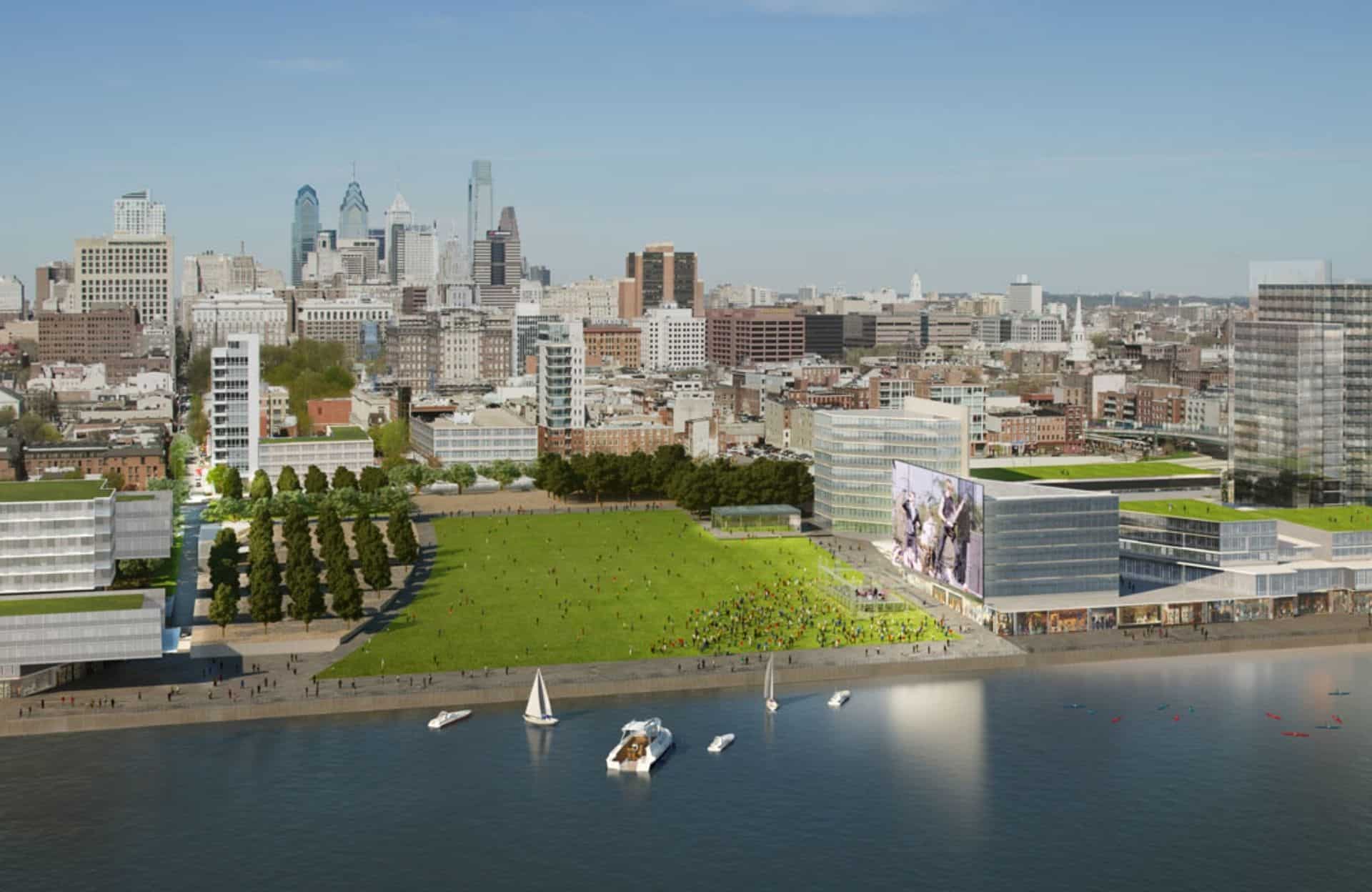The Delaware Riverfront in Philadelphia is in the mixing bowl of design and green city planning. The program intends to balance environmental, social, and economic concerns in improving the living conditions of the local communities. By operating in conjunction with natural processes and the built environment, the project aims to convert the region into a shared community resource rather than a private territory. This approach focuses on the long-term benefits to public health and community welfare, rendering the riverfront a collective asset for all.
What is Sustainable Planning?

Since the late 20th century, sustainability has carved out an important niche in coastal management programs, altering coastal planning and design decisions. Presently, there is a stronger emphasis on the incorporation of land use planning with sustainability principles, indicating ever greater importance being attached to these ideas in policy formulation.
Coastal zone management in the 1960s and 1970s was primarily concerned with urgent issues, with substantial advances being made in the 1980s and 1990s. At first, this involved a rational planning model, whereby issues, goals, and alternatives were identified, with actual choices differing from jurisdiction to jurisdiction. Nevertheless, by the 1990s, many countries had changed direction from treating coastal management as an urgent situation to implementing an accommodating planning model, beginning with Europe, as it stresses the contributions of various stakeholders.
At present, sustainable planning is a must for any development along the coast. This would mean engaging the public and private interest groups, non-governmental organizations, and communities in the planning process, therefore promoting interaction and developing a consensus. The waterfront design guidelines have been established as working tools to implement the above planning principles in different states.
New Perspective on Delaware Waterfront

Sustainable sites integrate natural processes with urban systems to promote environmental, social, and economic benefits that improve the quality of life in Philadelphia. The city is committed to long-term sustainability for its shoreline with consideration for ecosystem restoration as one major component of its new infrastructure projects. This study stresses the need to see the waterfront in a new light, recognizing natural processes as vital partners in the restoration project.
To address environmental issues, we need to change our view on public space and resources shared by all. Streets, traditionally considered as mere corridors for vehicular traffic, can be transformed into lively corridors that contribute to the improvement of water and air quality, public health, and social cohesion. The riverfront, conversely, should be viewed as much more than an arena for private profits; it is, or should be, a shared resource that promotes habitat, social recreation, and education while working toward bright new solutions for the city’s sewer problems. All of the interventions under consideration must ensure that the Delaware Waterfront truly reflects what the community wants and hopes for.
Analyzing the Sustainable Strategies

Sustainable strategies are, however, well expressed in the analysis of both human-built and natural systems in the Upper Delaware Estuary. Different types, which use different forms of ecological designs, are laid out along the river, with real and specific examples thereof, as a means of demonstrating good landscape management. New initiatives in planning for the Delaware River aim to bring together development and ecology better. In this way, the provisions such as Riverfront Zoning Overlay-regulating land use and stormwater management plans of the Philadelphia Water Department (PWD) as well as plans of public infrastructures by the Philadelphia City Planning Commission (PCPC) for the North Delaware Riverfront become the umbrella of key strategies with which these projects are viewed: There exists a very promising potential for infusing ecology into all evolving plans and regulations at the municipal level. From this evidence, it could be possible to mention several projects that add an ecological dimension while formulating the given development grant. For instance, PennDOT is planning the redevelopment of part of I-95 at the Girard Interchange; PWD is integrating the management of all stormwater to be generated from new projects; EPA is mandating separation of combined sewer overflows (CSO); there is the Estuary Restoration Act; and last, but not least, there are new waterfront developments along Delaware Avenue and the river.
Future of the Delaware Riverfront
In major cities like New York and Chicago, revitalizing former industrial waterfronts has sparked economic growth and enhanced community life. Philadelphia has a remarkable opportunity to revitalize its central Delaware riverfront into a lively, green area that encourages recreation and fosters community ties. This redevelopment is anticipated to invigorate the entire city, supporting the growth of Center City and drawing in more residents, workers, and visitors.
There is a long stretch of the 7-mile riverfront planned for hundreds of millions of square feet of new housing, leisure, and retail development. The manner in which these projects are implemented, in conjunction with public investment, will affect these shorelines into the next century.
In 2006 Mayor Street laid out a vision for the central Delaware riverfront and appointed Penn Praxis at the University of Pennsylvania Weitzman School for Design to coordinate the initiative. Over 13 months, Penn Praxis’s staff and University experts facilitated dialogue amongst a diverse range of stakeholders, from residents to elected officials, in the design of a civic vision. The process involved 4,000 Philadelphians and culminated in the publication of “A Civic Vision for the Central Delaware” in November 2007.
Implementation of a Civic Vision

The Central Delaware Action Plan outlines a 10-year strategy for revitalizing the riverfront. Its primary objective is to connect redevelopment efforts with a community vision that enhances accessibility for residents, boosts the local economy, and improves the environmental quality along the river. The plan details the specific actions required for redevelopment, identifies the responsible parties, evaluates costs, and points out potential funding sources. It does not attempt to predict unpredictable market dynamics or control private development; instead, it establishes a public framework that encourages organized and thoughtful private investment.
The action plan is driven by a coalition of fifteen neighborhood associations within the central Delaware area, aiming at ten objectives in the first decade. These neighborhoods believe that riverfront development will be a key ingredient for Philadelphia’s future and will give life to the city.
The action plan lays out practical steps to revitalize Philadelphia’s waterfront, making it clear that these are realistic goals rather than mere dreams. It points to successful examples from other cities that have taken similar short-term and long-term actions between 2008 and 2018. The plan underscores the necessity of civic and political will to turn these ideas into reality.
How to Implement the Civic Vision for the Central Delaware?
To implement the Civic Vision for Central Delaware, the proposal suggests establishing an independent organization for waterfront development and management. It also emphasizes the significance of strategic public investment, a clear zoning code, and a comprehensive array of incentives and regulations. Leadership from the mayor and City Council is crucial to ensure a transparent process that builds community trust. Besides, the plan calls for a sincere public-private partnership with the riverfront property owners for mutual gain in providing transit, traffic management, and investment in parks and greenways, which would enhance the economic opportunity for both property owners and the city.
A Civic Vision for the Central Delaware Suggests Major Changes for the Riverfront
One of the significant areas where the city benefitted from the new plan would be the waterfront of the Delaware River. An area such as this would make itself more accessible and usable by everybody. The future would bring to it the part of the streets, and parts of the river, a walkable boulevard, and the establishment of a trail that’s recreationally around the place. The plan would also make a provision for a lane for the bus and another for the bike, plus parks every quarter mile, and a 100-foot green strip to filter runoff and sustain local wildlife. It envisions a radiant area with houses, shops, and office buildings that connect closer to neighborhoods with the river.
Important Benefits of the Delaware Riverfront

The project offers many important benefits.
- First, it emphasizes economic development, that is, the activity is seen to be contributing positively to the local economy.
- Second, it notes the recreational opportunities and enjoyment afforded to the community, thereby enhancing the quality of life.
- Third, it also adds new features along the river that make the neighborhood more attractive.
- Finally, it mentions environmental effects: pollution reduction related to the initiative and overall river health enhancement.
Actions Required to Protect Riverfront Communities
The plan aims to enhance the central Delaware riverfront by emphasizing public input and establishing guidelines for evaluating ongoing development projects. It recommends modifications to ensure that Penn’s Landing Corporation operates with greater transparency and accountability in its management of the waterfront. Additionally, the plan introduces new zoning regulations to better manage public spaces, access routes, and parking along the river
The central Delaware waterfront stretches from Oregon Avenue north to Allegheny Avenue alongside I-95 and the Delaware River and includes neighborhoods such as Whitman, Penn Sport, and Fishtown. Currently, the area consists almost exclusively of a combination of large box stores, an industrial port, and residential towers, but casinos and further residential work will follow.
The Civic Vision for Central Delaware grew out of a year-long planning initiative led by Penn Praxis and commissioned by Mayor Street in 2006, where more than 4,000 people contributed their views to envision a riverfront for the next 30 years. Awarded in 2008 by the Congress for New Urbanism, this initiative is one of the most recognized urban planning movements with a national Charter Award.
The Design Aims for A Connected, Public, And Authentic Philadelphia Waterfront.

Designed with sustainable and resilient qualities, this waterfront neighborhood seeks to create a lasting community. It integrates many natural elements, including parklands, rain gardens, and urban forests, and will increase access to the waterfront while maintaining an atmosphere at a human scale. Rainwater would be absorbed naturally into the landscape, enhancing air quality and supporting a livable urban ecosystem.
It has been determined that New work will be constructed according to innovative green technology meeting full Passive House standards. The public realm will tie together the neighborhood, celebrate local art, and acknowledge the cultural diversity of the city. Retail spaces on the ground floor will celebrate Philadelphia’s local flavor while providing incubator space for creatives and innovators. The project pays respect to its history in the careful selection of materials, artwork, and interpretive landscape elements.
This undertaking is being spearheaded by Penn’s Landing Community Partners, LLC, including several renowned firms. The planning and design team is comprised of experts in architecture, master planning, landscape architecture, transportation planning, resilient infrastructure, civil engineering, and community engagement.
Conclusion
The Delaware Riverfront project in Philadelphia aims to reconnect the city with its riverfront by promoting sustainable development and restoring the ecosystem. Important initiatives include the Riverfront Zoning Overlay, plans for managing stormwater, and enhancements to public infrastructure, all intended to harmonize ecological factors with urban expansion. The main objective is to create a lively and resilient urban space that meets the needs of residents while also supporting the natural environment.

Leave a Reply